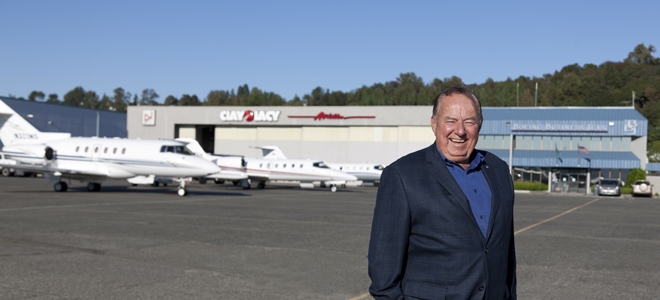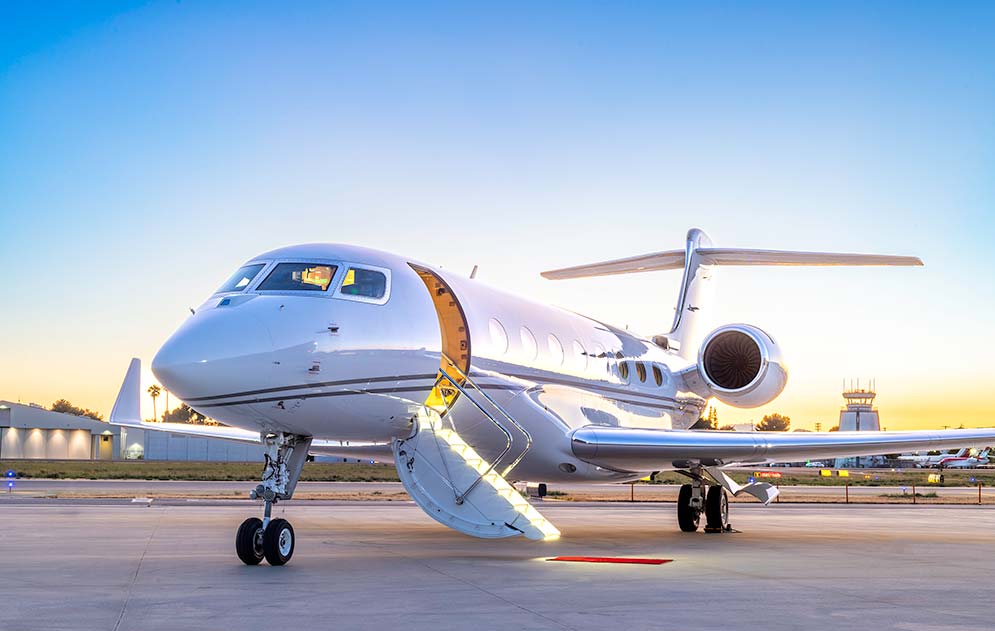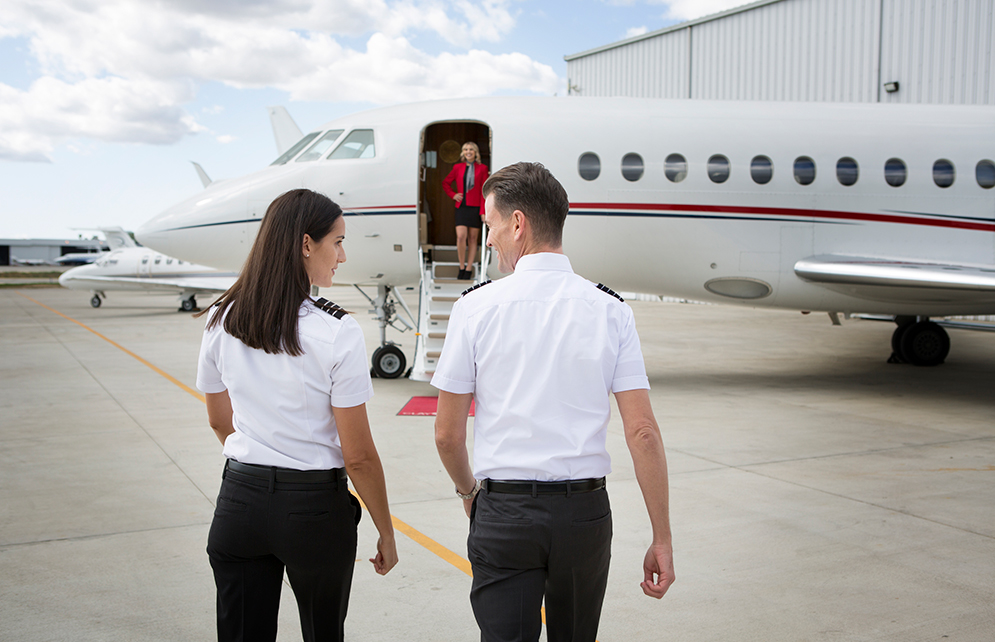
Keeping Bizav Strong After National Tragedy
By Clay Lacy In Professional Pilot Magazine’s October 2001 “Guest Editorial”
ATP/CFII/Helo/Sea.
Boeing 747, Gulfstream II/III/IV,
Hawkers, Learjets, Citations and
25 misc type ratings
GOVERNMENT DECISIONS SHOULD NOT CRIPPLE A VITAL SEGMENT OF TRANSPORTATION — GENERAL AVIATION.
Like everyone else in the free world, I was shocked and saddened by the tragedies in New York, Washington DC and Pennsylvania on Sep 11. I can’t imagine anything worse happening and I can’t understand people who would do such things. But this has been a real wake-up call. Now that it’s happened, there are security issues, procedures and bigger questions we have to address.
Evidently, there was no plan in place to deal with civil aviation in the event of any kind of national emergency. So we just immediately canceled all flying—which was probably all we could do and the smart thing to do. When we got around to reinstating flying, it was done piecemeal and, I believe, without a well thought out plan. Hopefully, nothing like this—airliners flying into buildings—will ever happen again. But we need to have an emergency plan and defined priorities for who gets grounded and for what, based on risk, should another national emergency affecting aircraft ever occur again.
Reinstatement of flying has been less than desirable, with priorities not as well thought out as they could have been. Soon after the attacks, for instance, the President said many times that he wanted to keep business and the country moving normally. But corporate flying was shut down for 4 days and foreign-registered executive aircraft were still banned from the country 11 days after the event. It seems to me that the first people you’d want to have flying in order to keep things running normally are the top people in the nation’s biggest companies. In my opinion, business aviation should have been up flying first, even before the airlines.
No corporate aircraft has ever been hijacked in this country and, so far at least, terrorism has not been a problem in our industry. In fact, corporate aviation is the most secure way of traveling in the world today. Many of the new corporate jets have sophisticated security systems built in and you have the advantage of knowing who your passengers are. It’s not like an airline, where you pick up hundreds of people randomly out of the population.
While the airlines and Part 135 operators were back in the air within a couple of days, and European business aviation was flying within about 24 hrs, the US corporate aviation fleet remained shut down and grounded. I was in Venice, Italy, with a friend and his Dassault Falcon 900EX when the attacks happened. We didn’t like the idea of sitting there as the only N- registered corporate jet aircraft on a foreign airfield. We flew to Edinburgh, Scotland, late Thursday afternoon to be a little closer to the US. But it was another couple of days before we could fly back, and then only via Canada. I’m not trying to be overcritical, but I think in the future we need to have a plan in place and we need to evaluate what the risks of various facets of aviation really are.
As I write, 11 days after the attack, foreign-registered business aircraft still cannot land in the US. In recent hours they’ve been permitted to overfly the US but only if they’re under 95,000 lbs MTOW, which would exclude Boeing BBJs and Airbus A319CJs. DCA (National, Washington DC) and TEB (Teterboro NJ) are still closed to all corporate aviation. Meanwhile, news reporting and traffic watch aircraft are still barred from flying. Gliders and ultralights, however, are permitted to fly. While there’s never been a hijacking incident or a security problem with traffic watch and news reporting aircraft, they still can’t fly 11 days later. Ultralights can, and we have no control over them. You don’t have to be a licensed pilot to fly one and anyone can take off from a parking lot wearing a belt of explosives.
I feel our government has been highly effective, overall, in dealing with this horrible tragedy. This all happened so fast they didn’t have a chance to fully evaluate the various risks and priorities in reinstating flying. And I’m not sure the people in charge were all that familiar with business and general aviation to start with.
BIZAV STILL STRONG
I hate to see any business profit from a bad and tragic experience like this, but I think it’s in the cards that all facets of business aviation are going to gain from these recent events. Requests for charter aircraft and fractional aircraft services are running at an all-time high as those who can afford to avoid the airlines are doing so. I’ve talked with a number of aircraft dealers over the past few days and they’re getting lots of calls from people inquiring about buying their first aircraft.
People are re-evaluating their travel plans these days. Many are thinking long-range and avoiding the airlines. Here at Clay Lacy Aviation (CLA) we’re now booking a lot of trips 1 and 2 months in advance rather than the more usual 1-week advance notice.
Unfortunately, I don’t see how anyone’s going to be able to solve airline security problems right away. Business aviation, for the foreseeable future, will do nothing but get stronger, and those who can afford to will use charter, fractional and traditional flight departments for both convenience and security.
I believe FBO and flight department security is adequate, although everyone can be more aware and vigilant. Here at CLA, we’ve always had a secure ramp but we’ve now tightened security on who we allow on our ramp. Also, instead of taking bags directly to aircraft, we set them beside the airplane and confirm the bags with passengers before loading them. We’re also doing more thorough checks on new customers. If someone new wants to book a flight, particularly with cash, we check references and look for additional information.
Corporate aviation is the safest and most convenient way to travel the world has ever known. Nobody in this industry wants to see poorly thought out restrictions on business aviation, which could defeat its free mobility, convenience, safety and business value.
SECURITY ISSUES
I flew with United Airlines for more than 40 years, from Jan 1952 to Aug 1992. Throughout those years I always felt that hijacking or terrorism was one of the biggest threats to me as an airline pilot. While airline operations manuals clearly state that pilots should do what hijackers want in a hijack situation, I always had some little plans in mind. One option I considered was making a “fasten seat belts” announcement and then zero-G-ing the aircraft a couple of times. Another would be to open the dump valve and depressurize the cabin. While these tactics might work in a particular hijack situation, they’re not the final solution.
The airlines should probably increase the strength of flightdeck doors and perhaps even bulletproof both the bulkhead and flightdeck door with Kevlar. A double-door system, such as you see in some jewelry stores and foreign banks, may also be an effective measure. I believe there should also be video cameras in the cabin so that the flightcrew can assess the situation should an event—say, air rage or attempted hijacking—be in progress, and not go back into the cabin with no knowledge of what’s happening. However, I don’t feel we need to go as far as some have suggested in locking the pilots in the flightdeck before the passengers board and only letting them out after they deplane.
Arming airline pilots, as some have suggested, is not necessary and probably not a good move. If an unarmed hijacker were to get into the flightdeck and take a gun from a pilot by force, he’d now have a gun which he didn’t have before and could use it on the crewmembers. I hate to think it will be necessary to carry air marshals on board the airlines, but we did have them for a while back in the late 60s. An air marshal takes up another seat and reduces payload— all things that hurt the airlines. And if you arm air marshals, you’re making another gun potentially available to a hijacker. Nobody wants gunfights up in the air. Air marshals may be a temporary response to give people more peace of mind but, again, they’re not the final answer.
RESPONSE TO TERRORISM
At least a part of the solution is to make the world realize that we’re not going to stand for terrorism. I think President Bush has made this point very well in his recent speeches. Another issue which has come out of all this is the need to boost our global intelligence network. Unmanned aerial vehicles (UAVs) have proven to be a highly effective means of augmenting satellite observation technology. Both UAV and unmanned combat air vehicle (UCAV) technology are here to stay. A fleet of UAVs can provide effective visual cover over suspected trouble spots and recent news reports indicate that the Afghans have already encountered and shot down an unmanned surveillance aircraft.
While satellite and UAV technology are effective, we seem to have lost the “James Bond 007“ guy who can infiltrate countries and hear what’s really going on. We’re going to need more intelligence people on the ground and, so far at least, we can’t accomplish this job by sending in robots.
Looking at the bigger picture, Americans will have to make greater efforts to understand the rest of the world than we have in the past. I believe many in the third world may be a little jealous of the US and feel we’ve been too successful and had things a little too easy. We don’t understand and appreciate different world cultures as much as we should. While we must be firm on a zero-tolerance policy toward terrorism, we must also make it clear to the peace-loving majority of the Muslim and Arab world that we respect their religion and cultures and that we’ll treat them evenhandedly.
SUMMARY
Corporate aviation has not yet had a problem with terrorism and, I believe, we currently have a safe and secure bizav transportation system. There are measures we can take to further improve security of our operations, such as a general increase in vigilance and background checks on new charter customers and employees, but we don’t want to build unnecessary problems and complications into the business aviation industry.
We saw an example of misdirected priorities recently in the grounding of Part 91 operations for longer than was perhaps necessary. I believe NBAA and NATA need to be proactive in promoting a plan the government will accept before restrictions and regulations get thrown at us that we don’t want or need.
Today, the global economy is readjusting itself. There could be 1 million people laid off over the short term and that’s not a good picture, in my opinion. But, as far as corporate aviation is concerned, I don’t think business can get along without it any longer. I always remember the billboard Bill Lear put up in 1965 near the airport in Dallas. It read, “Welcome to Dallas. Your competition has been here and left in a Learjet.” Today, this is truer than ever, and corporate aviation has become a necessary element in the global economy.


